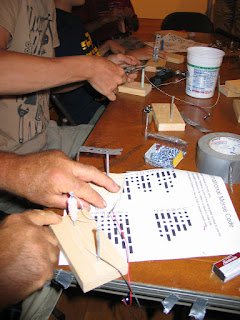There were so many challenges with this project. First there was the design challenge. When given a piece of paper and asked to draw a figure, almost all of the students were completely stopped in their tracks. They simply couldn't come up with anything. We made suggestions such as a fish, bat, robot, etc. In the end almost all of them ended up copying one of our designs.
Designing the circuit also proved to stump almost all the students. In retrospect, I should have had an entire after school class devoted to experimenting with simple circuits as it was clear the kids didn't understand how to connect the battery to the LEDs.
The challenges continued when the students then needed to cut out their paper and then their felt. Many of them (4th and 5th grade) didn't have the manual dexterity to use scissors. We had to do the cutting for several of them.
I quickly realized the next steps would also be a problem--threading the needle and sewing. One girl had sewn before, but the rest of them quickly had difficulty threading their needle, knotting the thread, and sewing a straight stitch. I untangled many, many attempts.
This was a frustrating afternoon for many of these kids. For some, a lack of resiliency, made them give up almost before they began each step.
This project which combined art, technology, and basic craft skills proved to be really, really challenging. If I were to do it again, I would offer it only to middle school students and make it a multi-session program where we worked on each of the components more slowly.
To be honest, I'm not sure e-textiles will come back to the Learning Lab anytime soon. They components are expensive and, while there is a TINY connection to our collections and history, I can think of other more engaging activities that help us reach our goals.

Supplies:
Coin cell battery holder
LED
Conductive thread
Felt
Needles
Scissors
Paper & pencils














